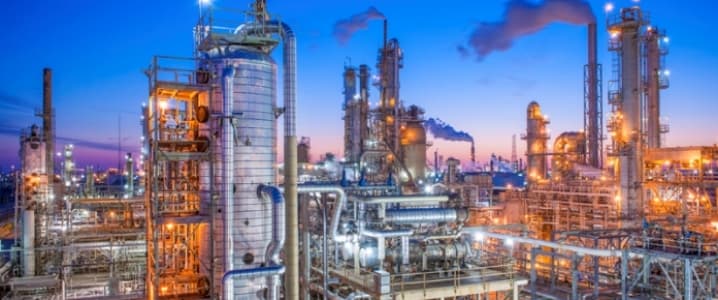(Repeats Monday’s column with no changes to text. The opinions expressed here are those of the author, a columnist for Reuters.)
* Fund positioning on CME copper: tmsnrt.rs/2Myafvs
* LME Index vs China PMI: tmsnrt.rs/2YnPVnD
* Global Vehicle Production: tmsnrt.rs/2YqBKy7
By Andy Home
LONDON, Aug 5 (Reuters) – If you believe that “Doctor Copper” is a sensitive gauge of the health of the global economy, then you should be worried.
London Metal Exchange (LME) copper fell through the year’s low of $5,725 per tonne on Friday and hit a 26-month low of $5,640 early on Monday.
The trigger for the slump was the latest escalation of the trade stand-off between the United States and China, President Trump announcing the imposition of more tariffs on Chinese goods effective the beginning of next month.
Copper has been used as a proxy for trading the on-off trade talks for some time and funds had amassed a significant short position on the CME copper contract even before Friday’s break-down.
However, what’s troubling Doctor Copper and just about every other LME-traded base metal, with the single exception of nickel, is the accumulating evidence of a global manufacturing downturn.
Quite evidently, an escalation of trade tensions between the world’s two biggest economies is not going to help an already fragile industrial economy.
THE TRUMP TRADE AND THE BIG SHORT
Funds have for many months been expressing their views on the likely success of the trade talks via the CME copper contract.
When a positive outcome looked possible around the end of the first quarter, fund positioning switched to net long. But since then bears have amassed short positions as the prospects of a breakthrough have receded.
The latest Commitments of Traders Report shows money managers holding a net short position of 40,372 contracts.
Outright short positions totalled 86,841 contracts. That’s less than the record 101,593 contracts accumulated at the start of June but the latest report only covers positioning as of last Tuesday. The big short has almost certainly got bigger still, given the price action towards the end of last week.
Long positioning has been largely unchanged since the unwind of previous exuberance in April and May.
THE GLOBAL RECESSION TRADE
It’s not just copper that is being punished by speculators. LME aluminium, zinc, lead and tin are all now trading below year-start levels.
Only nickel is defying this broader trend, with investors keeping faith with nickel’s bull narrative of a lift in demand from the electric vehicle battery sector. It is the only LME metal still showing a net speculative long position, according to LME broker Marex Spectron.
What’s depressing the rest of the LME base metals complex is the deterioration in global manufacturing activity as shown by falling purchasing managers indices (PMI) the world over.
“For the first time in recent history we now have the majority of global manufacturing PMIs in contraction,” said BMO Capital Markets. (“Metals Brief”, Aug. 2, 2019).
The metal markets are particularly sensitive to the health of China’s massive industrial economy, which is struggling, according to both the official and Caixin PMIs. Both indices edged up in July but both, critically, remained below the expansion-contraction threshold.
Other key metals economies such as South Korea, Japan and Taiwan are also suffering.
Manufacturing activity in the euro zone goes from bad to worse, contracting at the fastest pace in July since late 2012.
The United States remains a rare bright spot, but even here activity is slowing fast. The Institute for Supply Management’s July index fell to 51.2 in July, the weakest growth rate in nearly three years.
AUTOMOTIVE PAIN
The automotive sector is a particular source of metals demand weakness.
World motor vehicle production fell last year for the first time since the financial crisis, according to the International Organization of Motor Vehicle Manufacturers.
Car markets are being hit both by the broader cyclical downturn and the structural challenge of transitioning from the internal combustion engine to electric vehicles.
This double whammy is particularly acute in China, the world’s largest car market and the one that is rolling out electric vehicles faster than anyone else.
Chinese vehicle sales have fallen year-on-year for 12 straight months, with expectations that car demand will slide some 5% this year after a 2.8% fall last year to 28.1 million units – the first decline since the 1990s.
Transport is an important end-use sector for metals such as aluminium, so look no further to understand why China’s exports of semi-manufactured aluminium products are booming even as national aluminium output flat-lines.
Exports of “semis” rose 8% in the first half of 2019 despite the proliferation of trade barriers and anti-dumping duties on Chinese products.
BACK TO SUPPLY
A breakthrough in U.S.-China trade talks could lift some of the manufacturing gloom but the prospects appear to be dimming after the most recent escalation of threatened tariffs by U.S. President Donald Trump.
Beijing, meanwhile, is working hard just to maintain economic stability by using targeted stimulus.
Hopes for a shock-and-awe metals-intensive stimulus package such as that seen in 2009-2010 and again in 2015-2016 have faded.
Beijing has made it quite clear it doesn’t want to repeat the mistakes of the past. The current stimulus pulse is largely bypassing the residential construction sector, another key end-use area for many base metals. Infrastructure spend, meanwhile, also appears to be bypassing the copper- and aluminium-intensive power grid.
With China’s manufacturing sector treading water and other countries’ activity rapidly decelerating, there is no reason for heavyweight fund managers to allocate money to the base metals sector, again with the possible exception of nickel.
Analysts such as those at BMO are looking for some improvement after the seasonal slowdown months of northern hemisphere summer and as destocking through the manufacturing chain comes to an end.
But, until there is “evidence of improvement (…) supply cuts may offer more hope for price upside” in the base metals complex.
That says as much as anything else about the state of global metals demand.
Editing by Louise Heavens
Our Standards:The Thomson Reuters Trust Principles.










AVIGNON – This January, 3,554 US economists – including 27 Nobel laureates, four former Chairs of the Federal Reserve, and two former Treasury Secretaries – proposed a previously heretical policy. The United States, they said, should combine a domestic carbon price with a “border carbon adjustment system.” By backing tariffs that would reflect the carbon intensity of key imports, they broke with the free-market orthodoxy that national environmental policies should not impede global trade liberalization.
They were right to do so. Absent carbon tariffs, concerns about industrial “competitiveness” will continue to constrain vital action to counter harmful climate change.
The fundamental obstacle to decarbonization is the apparent paradox that the costs are trivial at the final consumer level, but large for an individual company. As the Energy Transitions Commission’s recent Mission Possible report emphasizes, the technology to achieve total decarbonization of the global economy by around 2050-60, with very small effects on households’ living standards, already exists. If all steel used in car manufacturing were produced in a zero-carbon fashion, the price of a typical car would increase less than 1%. The total cost to decarbonize all the harder-to-abate sectors – heavy industries such as steel, cement and chemicals, and long-distance transport (trucking, aviation, and shipping) – would not exceed 0.5% of global GDP. Viewed from this perspective, there is no excuse for national policymakers failing to adopt policies that can drive progress to a zero-carbon economy.
But, viewed from the perspective of an individual company, the costs of decarbonization can be daunting. Producing zero-carbon steel could add 20% to total production costs, and producing zero-carbon cement might double cement prices. So any individual steel or cement company that committed to zero-carbon emissions, or was forced to do so by regulation or carbon pricing, could be driven out of business if its competitors did not face equivalent constraints.
This conundrum has so far stymied the effective use of explicit carbon prices to drive decarbonization. Almost all economists who accept climate science believe that carbon taxes, or prices set in an emission-trading scheme, must be part of any optimal policy response. But even in places where this theoretically desirable policy has been deployed – for example, within the European Emissions Trading System – carbon prices have played a less important role than either regulation or direct subsidization of renewable energy in driving decarbonization. The reason for this is either that carbon prices have been too low to make a major difference, or that the most energy-intensive heavy industries have been exempted. And those weak policies reflect the fear that higher carbon prices and more complete coverage will make domestic industry uncompetitive with imports from countries without such policies.
The obvious response is to impose carbon taxes in one country, or in a customs union of multiple countries, with an equivalent tariff per ton of carbon on carbon-intensive imports, combined with rebates of the tax for exporters. Ten years ago, when I was Chair of the UK Committee on Climate Change, we debated this possibility. But it was met by a wall of opposition. Such policies, it was said, violated WTO rules, were undesirable in principle, and would unleash tit-for-tat tariff increases justified by whatever environmental priority each country wished to pursue.
Since then, we have successfully used other policy levers to drive large-scale deployment of renewable electricity systems, with costs falling dramatically as a result. But in the industrial sectors, the multiplicity of alternative possible routes to decarbonization, and the fact that different routes will likely be optimal in different circumstances, makes it essential to use the price mechanism to unleash a market-driven search for least-cost solutions. And to do that, we need an answer to the competitiveness problem.
That’s why the ETC’s Mission Possible report argues for the inclusion of border carbon adjustments (carbon tariffs) in policymakers’ tool kit, and why so many leading US economists have reached the same conclusion. They now argue for a carbon price within the US, combined with border adjustments for the carbon content of both imports and exports. Such a scheme “would protect American competitiveness and punish free riding by other nations.”
But while the economists couch their argument in language designed to play well in the US, the policy could equally be applied by other countries to defend their industries against carbon-intensive imports from America, should the US choose to be a free rider in efforts to tackle global climate change.
Indeed, no country committed to addressing climate change should regard this policy proposal as a threat to its economy. If one country applies a tax of, say, $50 per ton of carbon dioxide emitted, with an equivalent border tax on imports and with a rebate for exporters, any other country doing the same will leave its industries in exactly the same relative competitive position as before either country introduced the policy. But companies in both countries would now face an effective carbon price.
Global political agreement on carbon pricing has proven to be elusive. A carbon tariff could unleash a sequence of independent national decisions that drive a beneficial “race to the top” in which roughly equal carbon prices spread around the world.
Sometimes, intellectual taboos should be dropped. Border carbon adjustment is an idea whose time has come. It could play a major role in driving progress toward the zero-carbon economy that is technologically and economically possible by mid-century.